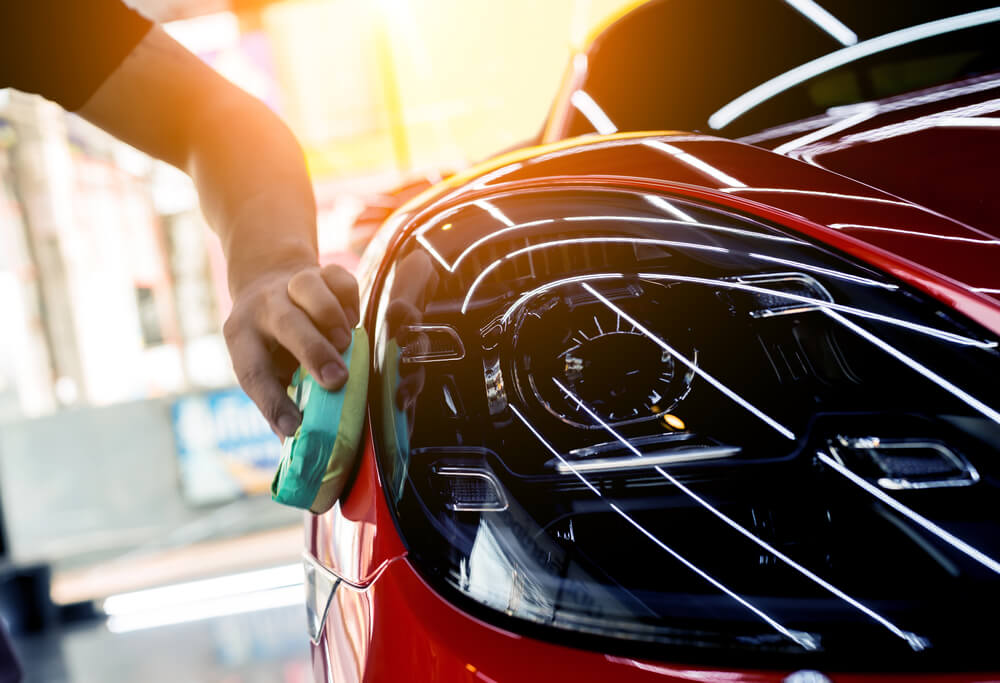The Value of Ceramic Coating: Safeguarding Your Vehicle's Outside With Accuracy
In a period where maintaining the functional and visual stability of your car is paramount, ceramic layer arises as a pivotal solution. This protective layer not just guards against ecological misfortunes but additionally boosts the visual allure of your cars and truck. With its distinct bonding homes, ceramic covering supplies a degree of protection that much surpasses typical waxing methods. Yet, exactly how precisely does it achieve such impressive results? As we explore the nuances of its application and contrast it to other choices, one can not assist yet wonder about the specifics that make this innovation essential for modern-day vehicle care.
Advantages of Ceramic Coating
When it comes to protecting an automobile's aesthetic charm, ceramic finishing provides significant benefits. By developing a semi-permanent bond with the lorry's paint, ceramic finishes successfully avoid oxidation and fading, guaranteeing that the car keeps a glossy, showroom-like finish for an extensive period.
In addition to its safety high qualities, ceramic coating offers impressive hydrophobic residential or commercial properties, creating water and various other liquids to bead off effortlessly. This attribute simplifies the cleansing procedure, as dust and debris are much less most likely to comply with the surface area, minimizing the frequency and initiative needed for maintenance. The finishing's resistance to chemical spots from acidic impurities like bird droppings and tree sap is one more significant benefit, lessening potential paint damage.
Ceramic coatings likewise boost scratch resistance, supplying a layer that can absorb minor abrasions and swirl marks. This feature is especially useful in keeping a beautiful surface area, lowering the probability of visible imperfections and protecting the honesty of the vehicle's paintwork with time.
Exactly How Ceramic Layer Functions
Comprehending the auto mechanics behind ceramic coating reveals its effectiveness as a safety remedy for automobiles. Ceramic coverings are essentially liquid polymer applications that chemically bond with an auto's manufacturing facility paint, creating a protective layer. This layer functions as a barrier versus ecological contaminants such as grime, ultraviolet, and dirt rays, which can degrade an automobile's exterior in time. The essential element in ceramic layer is silicon dioxide (SiO2), which stems from quartz crystals and is recognized for its exceptional hardness and resilience.
Application of ceramic covering entails a precise procedure. This shield enhances the car's gloss and hydrophobic buildings, helping with less complicated cleaning by triggering water and pollutants to grain and slide off easily.
In addition, the finish's molecular structure supplies resistance to small scrapes and chemical discolorations. Unlike waxes or sealants that sit on top of the paint, ceramic coatings integrate with the surface, offering lasting defense. This assimilation is fundamental to its efficiency, making certain the vehicle's surface continues to be pristine for many years.
Contrasting Ceramic Coating to Alternatives
In the world of auto protection, ceramic covering stands as a powerful choice when compared to typical choices such as sealants and waxes. While waxes offer a temporary lustrous finish, typically lasting just a couple of weeks to months, ceramic finishes supply a longer-lasting option, commonly withstanding for several years. This sturdiness is connected to the chemical bonding that takes place when ceramic finishings are applied, developing a strong layer that is resistant to ecological threats.
Contrastingly, sealants, although even more durable than waxes, still fall brief of the durable defense offered by ceramic finishes. Sealers can normally last for approximately a year, giving a synthetic shield against specific elements. However, they do not have the superior hydrophobic residential or commercial properties and UV defense that ceramic finishings deliver.
Furthermore, ceramic coverings supply improved scratch resistance, which neither waxes neither sealants can efficiently match (ceramic coating). This is specifically valuable in preserving an automobile's beautiful appearance. In addition, ceramic finishes simplify maintenance initiatives by decreasing the adherence of dust and grime, consequently helping with easier cleaning. In recap, while traditional waxes and sealers supply standard defense, ceramic coverings offer a thorough, long-lasting option that considerably preserves the automobile and boosts's exterior coating.
Application Process Clarified
Applying ceramic finish to a car needs a thorough process to make certain ideal outcomes and durability. Once click here now cleansed, the lorry is dried out and brightened to get rid of any type of imperfections, as any existing swirls or scrapes can come to be a lot more noticable after the layer is applied.
Complying with surface area prep work, the application of the ceramic layer begins. The coating is normally used in a climate-controlled atmosphere to stop dirt bits from choosing the newly cleaned surface. Using an applicator pad, the ceramic coating is applied in small sections to make sure also protection. It is crucial to follow the producer's standards concerning the appropriate healing time and application thickness.
After application, the finishing web calls for a particular treating duration, throughout which the car needs to be protected from water and pollutants. This treating procedure can differ depending upon the item however generally ranges from 24 to two days. Inevitably, this thorough process is crucial in achieving a resistant and Find Out More glossy surface.
Maintenance Tips for Long Life
To keep the long life of a ceramic finishing, adherence to a self-displined upkeep regimen is essential. Regular cleaning is critical; make use of a pH-neutral automobile hair shampoo and soft microfiber gloves to prevent abrasions. Prevent automated auto washes, as their harsh brushes can compromise the covering's integrity. Instead, go with a hand wash to make certain thorough yet mild cleansing.
Post-wash, drying the vehicle with a tidy microfiber towel stops water areas that may degrade the layer with time. In addition, apply a ceramic covering booster every couple of months. These boosters strengthen the hydrophobic buildings and enhance the covering's safety capabilities, guaranteeing it remains efficient versus contaminants.
Maintain in mind that car parking areas play a critical role in maintenance. ceramic coating. Whenever feasible, park in shaded areas to lessen UV direct exposure, which can slowly weaken the finishing. For long-lasting storage space, think about utilizing a cars and truck cover for added defense versus ecological elements
Verdict
To conclude, ceramic coating functions as a crucial protective layer for car outsides, providing durable defense versus ecological elements such as dirt, crud, and UV rays. By creating a semi-permanent bond with the paint, it improves visual charm while maintaining the cars and truck's value. Its hydrophobic properties facilitate less complicated maintenance, identifying it from alternative safety approaches. Understanding the application process and adhering to maintenance referrals are essential for maximizing the durability and efficiency of ceramic layer.
When it comes to protecting an auto's visual charm, ceramic finish uses considerable advantages. By creating a semi-permanent bond with the automobile's paint, ceramic finishes successfully stop oxidation and fading, making sure that the automobile preserves a shiny, showroom-like surface for a prolonged period. Ceramic coatings are basically liquid polymer applications that chemically bond with an automobile's factory paint, developing a safety layer. In summary, while conventional waxes and sealers supply fundamental protection, ceramic finishings present a thorough, long-lasting remedy that dramatically boosts and maintains the car's outside surface.

 Rider Strong Then & Now!
Rider Strong Then & Now! Amanda Bearse Then & Now!
Amanda Bearse Then & Now! Sam Woods Then & Now!
Sam Woods Then & Now! Talia Balsam Then & Now!
Talia Balsam Then & Now! Dolly Parton Then & Now!
Dolly Parton Then & Now!